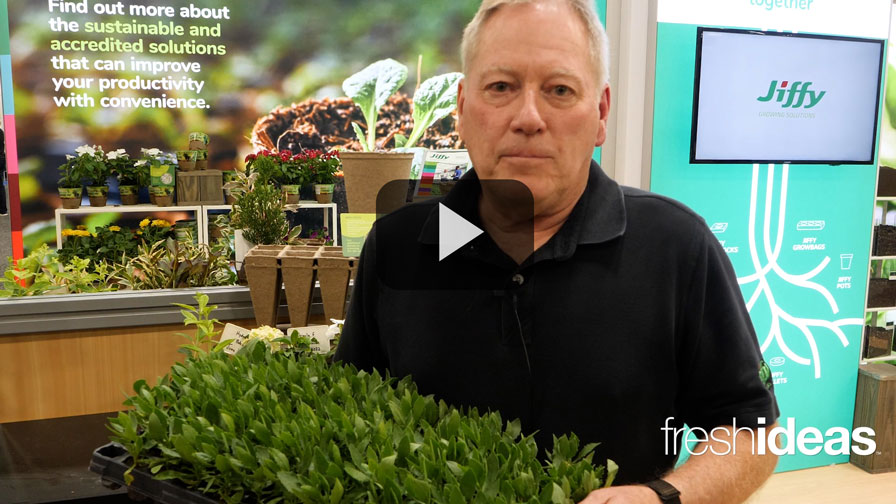Your Guide to High-Wire Tomato Growing
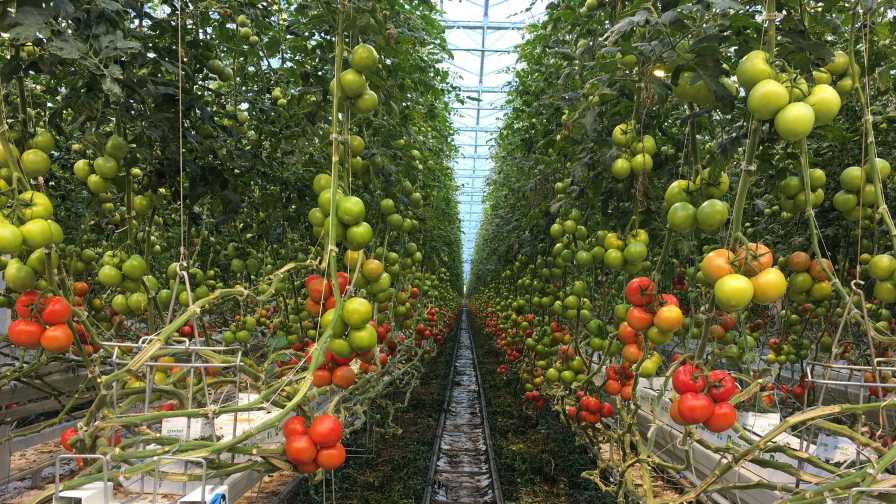
High-wire greenhouse tomatoes.
Photo courtesy of Cornell University
Growing tomatoes using a high-wire production system has become the go-to method for commercial greenhouse tomato production worldwide. While these systems can produce an enormous amount of tomatoes in a relatively small space, they also require a lot of labor-intensive maintenance to keep the plants healthy and productive.
Small- to medium-sized growers may choose to have a maintenance team that performs all of the different plant maintenance tasks. However, larger operations will typically divide their greenhouse workers into multiple teams, with each team focusing on a group of specific maintenance tasks. The various teams are usually based on the area of the plant that the work is to be done, which allows for specialization, time efficiency, and less room for costly errors.
Teams are typically divided based on the following maintenance tasks:
Lowering Plants
Well-maintained tomato plants grow rapidly, and once their tops reach the high wire, they must be lowered and leaned forward in the row. For each plant, the twine wrapped around the hook (which is hung on a high wire) needs to be carefully unwound a certain number of turns, with each turn lowering the plant a specific amount. The amount of turns and the frequency of lowering is dependent on the rate of growth of the tomato variety, but typically slower growing tomato types like beefsteak are lowered one turn per week, and faster growing tomato types such as cherries or tomato-on-vines (TOVs) are lowered one-and-a-half turns per week.
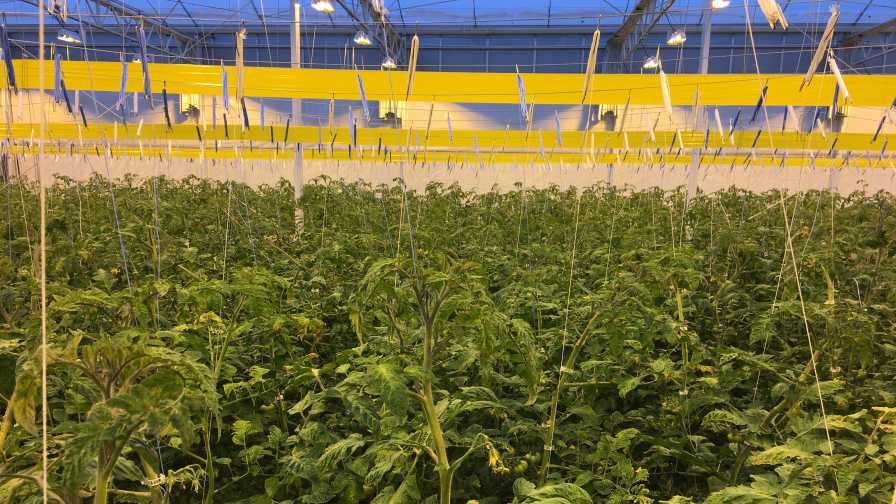
Recently lowered tomato plants.
Photo courtesy of Cornell University
This same maintenance group also has the important duty of adding new hooks. New hooks are added to a high wire when new heads are created. New heads are created by allowing a lateral branch (i.e., sucker) to grow and are created on a schedule set by the growers to increase the density of the crop (where a higher density can be used under summer/high-light conditions). The plants are immediately split into two heads after transplant, and by the end of their growth cycle beefsteaks will typically have three heads per plant, cherries will have three to four, and TOVs will have four to five. A new hook must be added whenever a new head is created.
Tip: When creating a new head, use a sucker directly under a flower cluster because they grow more vigorously than other suckers.
Top Work
Top work refers to most of the maintenance done around the top of the plant including clipping, removing suckers, and pinching flowers.
Tomato plants can either be clipped onto the twine using plastic or metal clips or the twine can be wrapped around the plants. Usually, cherry tomatoes will be wrapped, whereas beefsteak and TOV will be clipped. This is because beefsteak and TOV create more weight than cherries, and clips do a better job at distributing the weight. Wrapping can constrict the vascular system and lead to stem breakage for plants with heavier fruit weight.
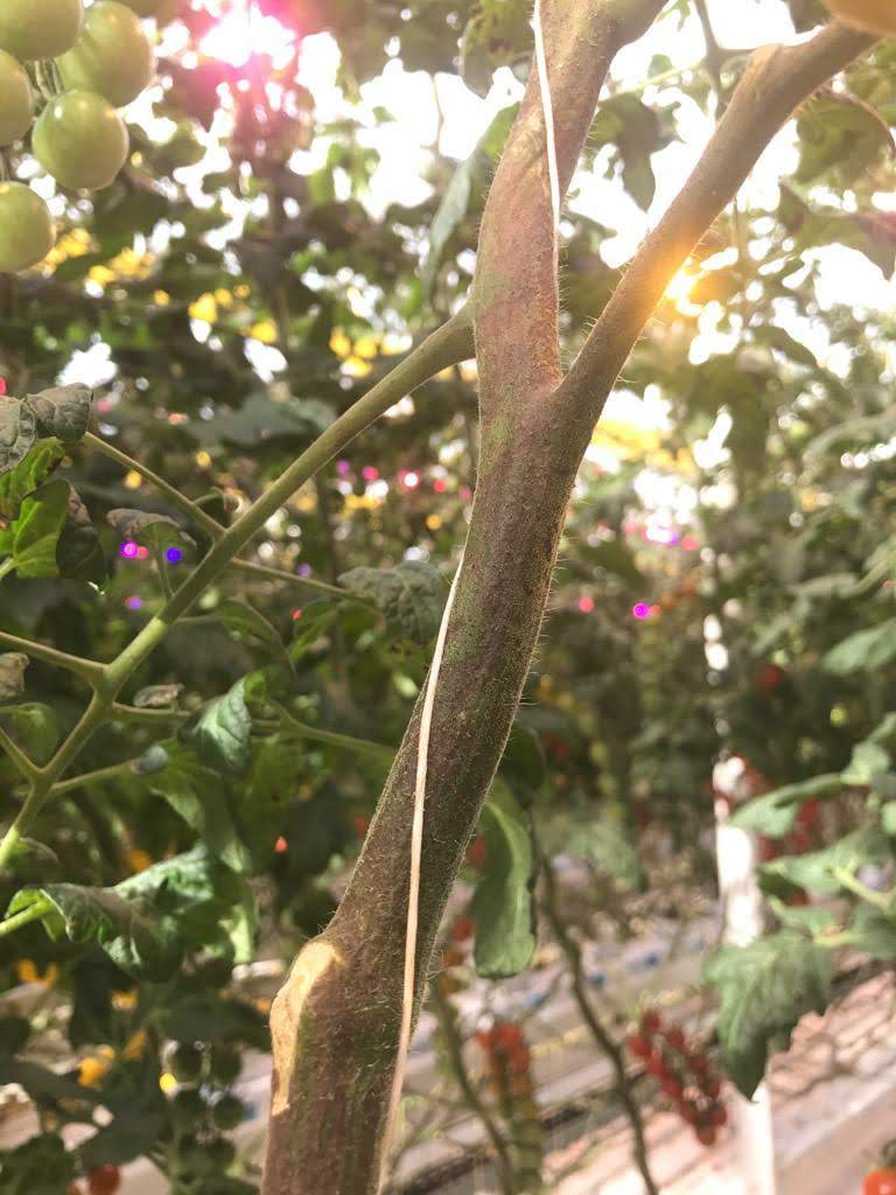
Wrapped cherry tomato plant.
Photo courtesy of Cornell University
As the plants are lowered, the stems must be clipped to the twine or wrapped so they remain trellised. Clips should be placed between two leaves and not under a flower cluster as it is likely to break off the cluster or otherwise make harvest more difficult.
Another task is removing suckers (i.e., lateral branches), which is extremely important as it conserves the energy of the plant and helps the growers to carefully control the density of the crop. Suckers should be removed by breaking or snapping them off the stem. Also, a full scan of the plant should be done monthly to remove any suckers that appear in the middle of the plant.
Pinching (or pruning) flowers is another important task and is done to remove excess flowers to pre-set the number of tomatoes per cluster. Depending on the variety, there is an ideal number of tomatoes per cluster — for beefsteak this is two to four tomatoes, for TOV it is four to six, and for cherries eight to 12. Flower pruning leads to better uniformity in fruit size and ripening, and it helps to avoid excessively large clusters, which can be unduly heavy and do not provide enough room for the fruits to grow to the proper size.
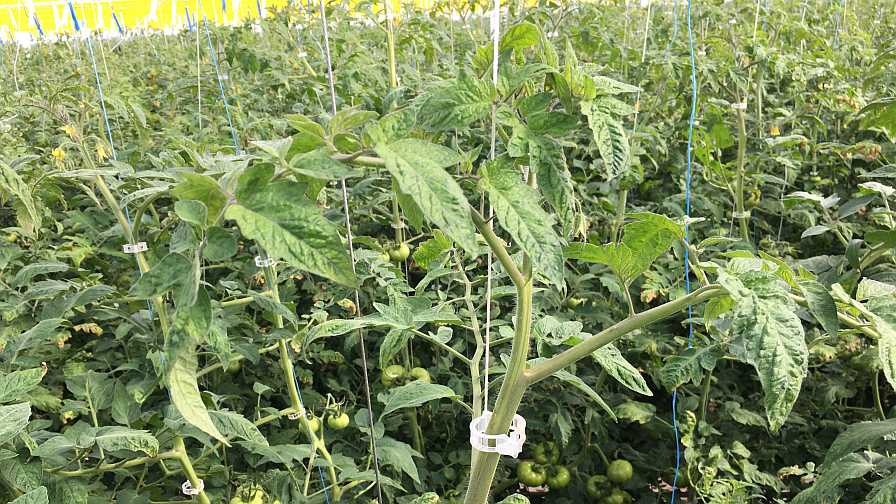
Clipped beefsteak tomato plants.
Photo courtesy of Cornell University
The number of flowers to be kept should be counted from the stem out and then the remaining flowers, those on the terminal end of the cluster, should be pinched off. Flowers shouldn’t be pinched until at least one flower has started to open on the cluster.
Each of these tasks should be completed weekly, and workers’ hands and any tools and equipment used should be sanitized between plants to keep diseases from spreading to the newly opened wounds.
Tip: Always remove the branch directly under a flower cluster. This will give the tomatoes more room to grow.
Removing Lower Leaves
The lower leaves of each plant must be removed because they are less photosynthetically active and removing them allows for better airflow throughout the crop. This task is done once a week and all leaves below and one leaf above the bottom truss should be removed. Deleafing also helps to expose the lowest fruit and make it easier to harvest.
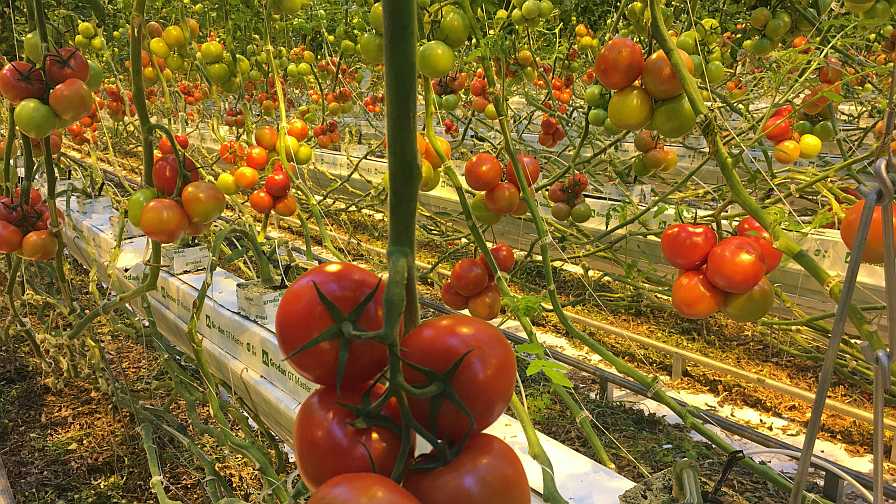
Rcently deleafed TOV tomato plants. Note the uniform fruit size and ripening caused by appropriate flower pruning.
Photo courtesy of Cornell University
Leaves should either be torn downwards or be removed with a knife, and the knife should be sanitized between plants. If using a knife, the leaves should be cut flush to the stem or else the stump that remains can stab the fruit.
Harvesting Fruit
Harvesting tomatoes is typically done once or twice a week and normally only one cluster is harvested at a time per plant. Depending on the type of tomato, the harvesting process is slightly different:
Cherries: The tomatoes can be torn off the stem, but they are often removed using a pair of clippers. Cherry tomatoes are typically harvested when completely ripe.
TOVs: The tomatoes are torn down and off, and then the cluster stem is trimmed so that it doesn’t puncture other fruit. TOV clusters are also harvested when completely ripe.
Beefsteaks: Each fruit is broken off above the calyx. Beefsteaks and any other tomato type harvested individually are harvested before they are ripe so that they don’t bruise as easily when put into boxes. The stumps that remain on the stem are ripped off later.
These duties may be done by four specialized teams in larger operations or collectively by one or more individuals in small operations. Either way, it is important to conduct the duties on time and in concert. A lapse in one duty can have rippling effects on the others. Thus, it is essential that all the teams work together to grow and maintain the healthiest, most productive tomato plants.






